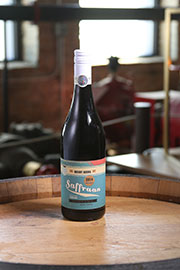- Analysis
- Vineyards
- Vinification and Aging
- Tasting Notes
- 2015 Vintage Notes
2015 Saffraan Cinsaut
Wine of Origin
Swartland
Varietals
100% Cinsault (Cinsaut)
Analysis
Wine Maker: Johan Meyer
Alcohol: 12%
Total Acidity: 5.3 g/l
pH: 3.75
Total Production: 500 cases
The grapes for Mount Abora wines are sourced from reputable sites in the Swartland. The soils are deep shale and schist and the vines are farmed essentially as dryland vineyards with supplementary irrigation to counter the extreme hot and dry conditions just before ripening. The vines are mostly planted on south and west facing slopes to optimise the benefit of cooler spots.
Mount Abora makes natural wines, using zero commercial yeast and no other modern winemaking preparations. We harvest our grapes earlier at no more than 23.5° Balling to not only ensure lower alcohol levels, but to retain the brightness and life of our carefully tended grapes as they transform into the wines. We liberally use whole bunch fermentation on red and white wines, and allow post fermentation hot maceration on skins and stalks.
The grapes were hand-picked at a low Balling from very flat-growing 36 year old bush vines on a slope facing South-West. Warm fermentation was allowed on skins and stalks, followed by warm maceration in tank. The wine was matured in older 300 litre French oak barrels for six months.
This wine has big, bright red fruit, and fresh red floral aromatics that leap out of the glass. Muddled strawberry, bing cherries and raspberry jam are the primary aromas. These pave the way for a subtle, almost spearmint like secondary aroma, with a mouth watering level of acidity. The palate is very fresh, and continues to evolve over time in the glass. This wine is best savored on its own, but when hunger strikes, enjoy with strawberry and salmon, or a peppered watermelon salad.
In 2014 we had a very wet winter which lasted much longer than expected. This resulted in vigorous growth when the temperature eventually started climbing. More rain in January made planning picking dates very tricky. I picked some vineyards earlier or in different stages to avoid the rain. Ultimately, the conditions during the growing season resulted in bigger crops in Swartland compared to 2013. Certainly a vintage with bigger berries, and thinner skins but this doesn’t show in the wines. They have more focus and are more austere than the 2013, which I quite like. 2014 at this stage is showing a real raciness and a mineral edge with an almost saline character we hope for, but don’t always get.

